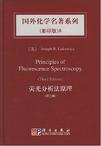荧光分析原理
出版时间:2008-3 出版社:科学出版社 作者:拉科维兹 页数:954
Tag标签:无
内容概要
本书在广受欢迎的前几版基础上修订而成。第三版保持了其侧重于基本概念的优点,更新了最新文献成果,增加了新的章节。主要内容包括:荧光仪器,荧光闭,荧光寿命,溶剂和环境效应,猝灭及其机理与动力学,各向异性,能量传输,蛋白质荧光,多光子激发与显微镜,传感器,DNA技术,单分子检测,荧光相关光谱,新型探针和辐射衰变工程等。 本书可供分析化学、生物物理、生物化学、生物工程、生物学和医学等专业高年级本科生、研究生、科研人员参考。
作者简介
作者:(美国)拉科维兹
书籍目录
1 Introduction to Fluorescence 1.1 Phenomena of Fluorescence 1.2 Jablonski Diagram 1.3 Characteristics of Fluorescence Emission 1.3.1 The Stokes Shift 1.3.2 Emission Spectra Are Typically Independent of the Excitation Wavelength 1.3.3 Exceptions to the Mirror-Image Rule 1.4 Fluorescence Lifetimes and Quantum Yields 1.4.1 Fluorescence Quenching 1.4.2 Timescale of Molecular Processes in Solution 1.5 Fluorescence Anisotropy 1.6 Resonance Energy Transfer 1.7 Steady-State and Time-Resolved Fluorescence 1.7.1 Why Time-Resolved Measurements? 1.8 Biochemical Fluorophores 1.8.1 Fluorescent Indicators 1.9 Molecular Information from Fluorescence 1.9.1 Emission Spectra and the Stokes Shift 1.9.2 Quenching of Fluorescence 1.9.3 Fluorescence Polarization or Anisotropy 1.9.4 Resonance Energy Transfer 1.10 Biochemical Examples of Basic Phenomena 1.11 New Fluorescence Technologies 1.11.1 Multiphoton Excitation 1.11.2 Fluorescence Correlation Spectroscopy 1.11.3 Single-Molecule Detection 1.12 Overview of Fluorescence Spectroscopy References Problems2 Instrumentation for Fluorescence Spectroscopy 2.1 Spectrofluorometers 2.1.1 Spectrofluorometers for Spectroscopy Research 2.1.2 Spectrofluorometers for High Throughput 2.1.3 An Ideal Spectrofluorometer 2.1.4 Distortions in Excitation and Emission Spectra 2.2 Light Sources 2.2.1 Arc Lamps and Incandescent Xenon Lamps 2.2.2 Pulsed Xenon Lamps 2.2.3 High-Pressure Mercury (Hg) Lamps 2.2.4 Xe-Hg Arc Lamps 2.2.5 Quartz-Tungsten Halogen (QTH) Lamps 2.2.6 Low-Pressure Hg and Hg-Ar Lamps 2.2.7 LED Light Sources 2.2.8 Laser Diodes 2.3 Monochromators 2.3.1 Wavelength Resolution and Emission Spectra 2.3.2 Polarization Characteristics of Monochromators 2.3.3 Stray Light in Monochromators 2.3.4 Second-Order Transmission in Monochromators 2.3.5 Calibration of Monochromators 2.4 Optical Filters 2.4.1 Colored Filters 2.4.2 Thin-Film Filters 2.4.3 Filter Combinations 2.4.4 Neutral-Density Filters 2.4.5 Filters for Fluorescence Microscopy 2.5 Optical Filters and Signal Purity 2.5.1 Emission Spectra Taken through Filters 2.6 Photomultiplier Tubes 2.6.1 Spectral Response of PMTs 2.6.2 PMT Designs and Dynode Chains 2.6.3 Time Response of Photomultiplier Tubes 2.6.4 Photon Counting versus Analog Detection of Huorescence 2.6.5 Symptoms of PMT Failure 2.6.6 CCD Detectors 2.7 Polarizers 2.8 Corrected Excitation Spectra 2.8.1 Corrected Excitation Spectra Using a Quantum Counter 2.9 Corrected Emission Spectra 2.9.1 Comparison with Known Emission Spectra 2.9.2 Corrections Using a Standard Lamp 2.9.3 Correction Factors Using a Quantum Counter and Scatterer 2.9.4 Conversion between Wavelength and Wavenumber 2.10 Quantum Yield Standards 2.11 Effects of Sample Geometry 2.12 Common Errors in Sample Preparation 2.13 Absorption of Light and Deviation from the Beer-Lambert Law 2.13.1 Deviations from Beer's Law 2.14 Conclusions References Problems3 Fluorophores 3.1 Intrinsic or Natural Fhiorophores 3.1.1 Fluorescence Enzyme Cofactors 3.1.2 Binding of NADH to a Protein 3.2 Exlrinsie Fluorophores 3.2.1 Protein-Labeling Reagents 3.2.2 Role of the Stokes Shift in Protein Labeling 3.2.3 Photostability of Fluorophores 3.2.4 Non-Covalent protein-Labeling Probes 3.2.5 Membrane probes 3.2.6 Membrane Potential Probes 3.3 Red and Near-Infrared (NIR) Dyes 3.4 DNA Probes 3.4.1 DNA Base Analogues 3.5 Chemical Sensing Probes 3.6 Special Probes 3.6.1 Fluorogenie Probes 3.6.2 Structural Analogues of Biomolecules 3.6.3 Viscosity Probes 3.7 Green Fluorescent Proteins 3.8 Other Fluorescent Proteins 3.8.1 Phytofluors: A New Class of Fluorescent Probes 3.8.2 Phycobiliproteins 3.8.3 Specific Labeling of Intraeelhilar Proteins 3.9 Long-Lifetime probes 3.9.1 Lanthanides 3.9.2 Transition Metal-Ligand Complexes 3.10 Proteins as Sensors 3.11 Conclusion References problems4 Time-Domain Lifetime Measurements 4.1 Overview of Time-Domain and Frequency- Domain Measurements 4.1.1 Meaning of the Lifetime or Decay Time 4.1.2 Phase and Modulation Lifetimes 4.1.3 Examples of Time-Domain and Frequency-Domain Lifetimes 4.2 Biopolymers Display Multi-Exponential or Heterogeneous Decays 4.2.1 Resolution of Multi-Exponential Decays Is Difficult 4.3 Time-Correlated Single-Photon Counting 4.3.1 Principles of TCSPC 4.3.2 Example of TCSPC Data 4.3.3 Convolution Integral 4.4 Light Sources for TCSPC 4.4.l Laser Diodes and Light-Emitting Diodes 4.4.2 Femtosecond Titanium Sapphire Lasers 4.4.3 Picosecond Dye Lasers 4.4.4 Flashlamps 4.4.5 Synchrotron Radiation 4.5 Electronics for TCSPC 4.5.1 Constant Fraction Discriminators 4.5.2 Amplifiers 4.5.3 Time-to-Amplitude Converter (TAC) and Analyte-to-Digital Converter (ADC) 4.5.4 Multichannel Analyzer 4.5.5 Delay Lines 4.5.6 Pulse Pile-Up 4.6 Detectors for TCSPC 4.6.1 Microchannel Plate PMTs 4.6.2 Dynode Chain PMTs 4.6.3 Compact PMTs 4.6.4 Photodiodes as Detectors 4.6.5 Color Effects in Detectors 4.6.6 Timing Effects of Monochromators 4.7 Multi-Detector and Multidimensional TCSPC 4.7.1 Multidimensional TCSPC and DNA Sequencing 4.7.2 Dead Times Repetition Rates and Photon Counting Rates 4.8 Alternative Methods for Time-Resolved Measurements 4.8.1 Transient Recording 4.8.2 Streak Cameras 4.8.3 Upconversion Methods 4.8.4 Microsecond Luminescence Decays 4.9 Data Analysis: Nonlinear Least Squares 4.9.1 Assumptions of Nonlinear Least Squares 4.9.2 Overview of Least-Squares Analysis 4.9.3 Meaning of the Goodness-of-Fit 4.9.4 Autocorrelation Function 4.10 Analysis of Multi-Exponential Decays 4.10.1 p-Terphenyl and Indole: Two Widely Spaced Lifetimes 4.10.2 Comparison of XR2 Values: F Statistic 4.10.3 Parameter Uncertainty: Confidence Intervals 4.10.4 Effect of the Number of Photon Counts 4.10.5 Anthranilic Acid and 2-Aminopurine: Two Closely Spaced Lifetimes ……5 Frequency-Domain Lifetime Measurements6 Solvent and Environmental Effects7 Dynamics of Solvent and Spectral Relaxation8 Quenching of Fluourescence9 Mechanisms and Dynamics of Fluorescence Quenching10 Fluorescence Anisotropy11 Time-Dependent Anisotropy Decays12 Advanced Anisotropy Concepts13 Energy Transfer14 Time-Resolved Energy Transfer and Conformational Distributions of Biopolymers15 Energy Transfer to Multiple Acceptors in One, Two, or Three Dimensions16 Protein Fluorescence17 Time-Resolved Protein Fluorescence18 Multiphoton Excitation and microsocopy19 Fluorescence Sensing20 Novel Fluorophores21 DNA Technology22 Fluorescence-Lifetime Imaging Microscopy23 Single-Molecule Detection24 Fluorescence Correlation Spectroscopy25 Radiative Decay Engineering: Metal-Enhanced Fluorescence26 Radiative Decay Engineering: Surface Plasmon-Coupled EmissionAppendix I. Corrected Emission SpectraAppendix II. Fluorescent Lifetime StandardsAppendix III. Additional ReadingAnswers to ProblemsIndex
编辑推荐
《国外化学名著系列8(影印版)》由科学出版社出版。
图书封面
图书标签Tags
无
评论、评分、阅读与下载
用户评论 (总计14条)
- 优点:内容全面,详实,荧光所需的知识基本上都涵盖了缺点:英语的啊,看起来费劲啊有木有,要是有翻译版的就好了
- 荧光分析的原理和技术都写得比较详细,还有一些新技术也做了介绍,还没看完呐,先写这些。
- 荧光方面很经典的一本书。
- 印刷质量好,内容很经典,就是英文原版读起来费劲.......
- 这本书不错,当当服务挺好
- 值得收藏,就是字太小了。
- 还没仔细读,看起来不错的很
- 书不错,就是书的边上和封面上有点脏,不过咱看的是书本身确实好
- 搞发光的经典啊,推荐大家看看。不过印刷不是太好,字太小,图没有彩色。还是原版的好,还是彩色的。
- 书的运送过程保管还是比较仔细的,只有微小的损坏,总之还是比较满意的~
- 内容详实,不可多得的学术参考
- 就是书的封皮有点坏
- 很不错的书,讲的很详细,只是有过有翻译版的就更好了。
- 这本书被人称为“荧光分析”的圣经,很权威的教材。可惜是影印版,原版里面的很多彩图都变成黑白的了。
